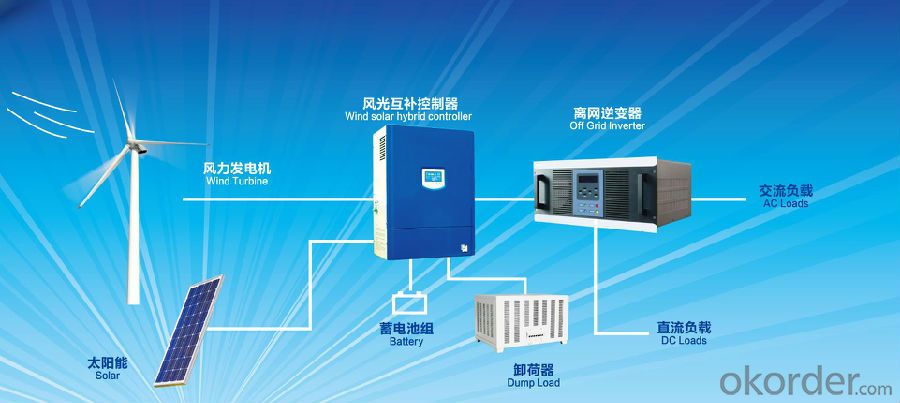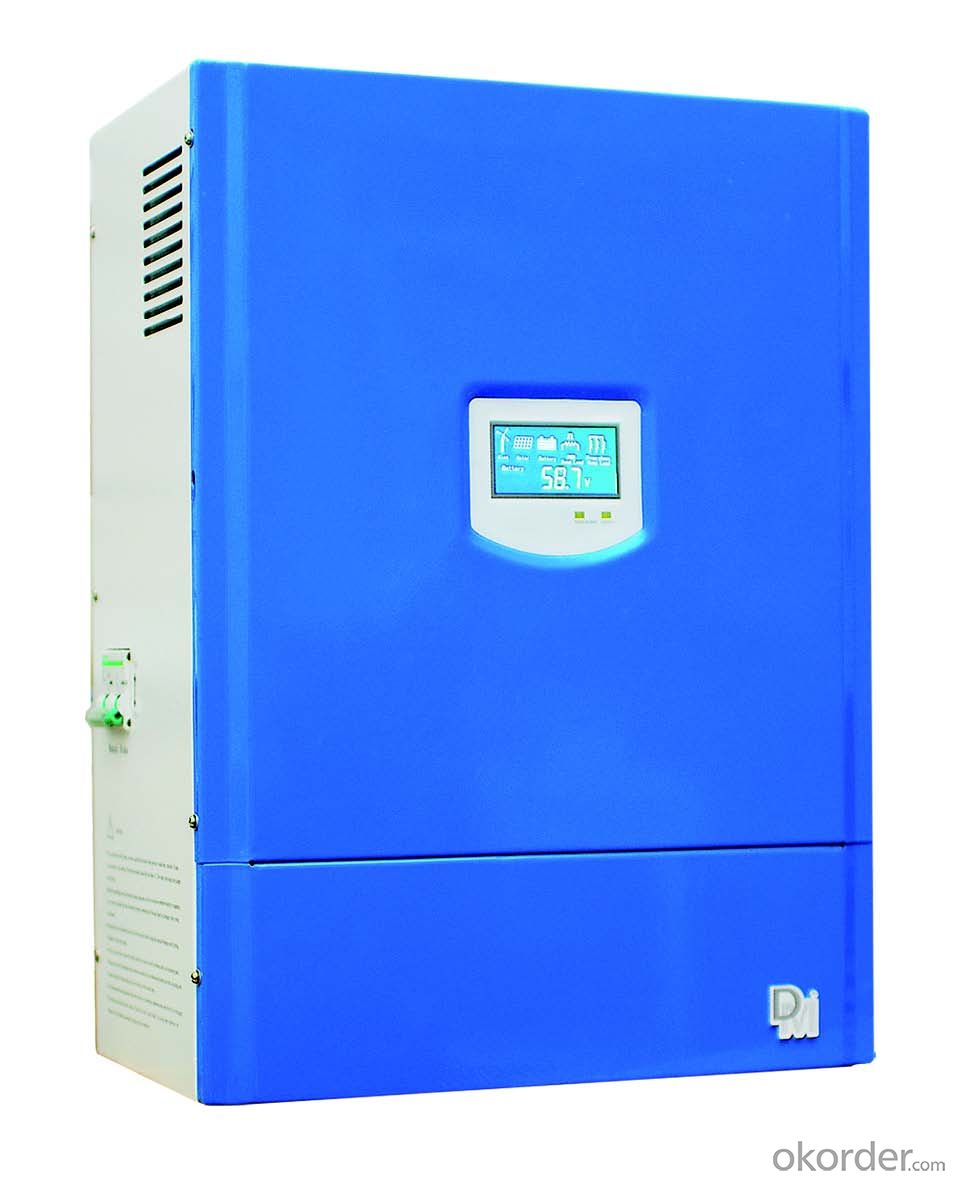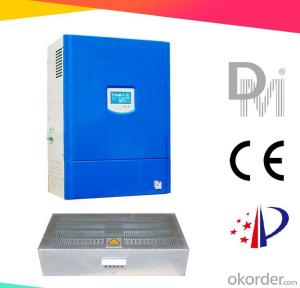Off-Grid PWM Wind Solar Hybrid Controller2KW
- Loading Port:
- Qingdao
- Payment Terms:
- TT or LC
- Min Order Qty:
- 1 unit
- Supply Capability:
- 1000 unit/month
OKorder Service Pledge
OKorder Financial Service
You Might Also Like

FKJ-B model Product Characteristics
◆The product is manufactured according the JB/T6939.1-2004 industrial standard and GB/T 19115.1-2003 national standard also with users’ technical requirements.
◆The big screen LCD display. Clearly present the working status of the wind turbine, solar panel, battery and controller.(Wind turbine voltage, current, power display ;solar voltage, current, power display, battery charging current, voltage, charging power, power display.)
◆Two sets of control systems:PWM constant voltage system and three-phase dump load system.
◆PWM constant voltage control is 120% of the rated power of the wind turbine. In case exceeding of PWM’s capacity, the three-phase dump load will automatically start immediately to ensure safe running of the overall wind turbine system.
◆When the battery disconnect or damage, the three-phase dump load will start automatically to avoid the wind turbine idling and runaway accident.
◆When the strong or super-strong wind conditions PWM control to ensure battery charged by the wind turbine with constant voltage and current.
◆The protection function of battery: polarity reverse protection, disconnection and damage protection.
◆Over-charging protection of the battery: When the battery is full (the battery voltage getting 125% of the rated voltage), the controller will carry out three-phase dump load automatically to stop charging the battery.
◆Auto recharging of battery: When the battery voltage reduces to 108% of the rated voltage,it stops three-phase dump load to recharge battery automatically.
◆For the different wind turbine type, the controller can be equipped with mechanical yawing, furled empennage, mechanical or hydraulic, pneumatic, electric magnetic and other brake functions.
◆The inside of the controller is equipped with surge arrester. Contain the over voltage into the wind turbine under the bearable voltage of the equipment or system. On the other way, to conduct the strong lightening current into the earth directly to avoid any damage of equipment.
◆The controller is equipped with manual three-phase dump load switch. To using this switch, the wind turbine will carry out three-phase dump load forcibly.
◆ Optional communication Mode:RS232、RS485、GPRS、USB、RJ45 ect, Can monitor multiple devices running.

Technical Parameters of the FKJ-B (PWM) Off - Grid Wind Solar Controller 2KW
Type | 2KW-24Vdc | 2KW-48Vdc | 2KW-96Vdc |
Wind turbine rated power | 2KW | 2KW | |
Wind turbine max. power | 4KW | 4KW | 4KW |
Solar panel power | 600Wp | 600Wp | 600Wp |
Battery | 24Vdc | 48Vdc | 96Vdc |
Function | Rectifier,charge, control | ||
Display mode | LCD | ||
Display content |
Wind turbine voltage, wind turbine current, wind turbine power, solar panel voltage, solar panel current, solar panel power, battery voltage, charge current | ||
PWM constant pressure voltage | >29Vdc | >58Vdc | >116Vdc |
3-phase load voltage of the wind turbine | 30±1Vdc | 60±1Vdc | 120±2Vdc |
Recovery charging voltage of the wind turbine | 27±1Vdc | 54±1Vdc | 108±2Vdc |
Solar controller stop charging voltage | 29±1Vdc | 58±1Vdc | 116±2Vdc |
Solar restore charge voltage | <29vdc< span=""> | <58vdc< span=""> | <116vdc< span=""> |
Low-voltage of the battery | 20±1Vdc | 40±1Vdc | 80±2Vdc |
Self-provided connecting wire of the battery | >20mm² | >10mm² | >24mm² |
PWM fuse | 100A | 50A | 20A |
Solar fuse | 40A | 20A | 10A |
Charging fuse | 125A | 63A | 32A |
Work environment temperature | -30-60°C | ||
Relative humidity | <90% No condensation | ||
Noise (1m) | <40dB | ||
Degree of protection | IP20 | ||
Cooling method | Forced air cooling | ||
*Communication interface (optional) | RS485/USB/GPRS/Ethernet | ||
*Temperature compensation (optional) | -4mv/°C/2V,-35°C~+80°C, Accuracy:±1°C | ||
Size of the controller (mm) | 480*360*130 | 480*360*130 | |
Weight of the controller | 23 Kg | 16 Kg | 16 Kg |
Size of the dump load (mm) | 395*300*125 | 395*300*125 | 395*300*125 |
Weight of the dump load | 6.5 Kg | 6.5 Kg | 6.5Kg |
*Above parameter only for reference
1. Could be custom made to user specifications.
2. Could have solar power control subject to user demand.
3. Size of the controller by blue meaning wall hanging case.
- Q:Can a solar controller be used with a solar-powered well pump?
- A solar-powered well pump can indeed be used in conjunction with a solar controller. The solar controller, otherwise referred to as a charge controller, serves the purpose of regulating the flow of electricity from the solar panels either to the batteries or directly to the load. When it comes to a solar-powered well pump, the solar controller plays a vital role in guaranteeing that the pump receives the appropriate amount of power from the solar panels, thereby preventing the batteries from being overcharged or undercharged. This optimization of the well pump's performance and efficiency ensures that it functions correctly and effectively. Moreover, the solar controller offers essential monitoring and protection functionalities, including overvoltage protection, short circuit protection, and temperature compensation. These features contribute to prolonging the lifespan of the batteries and the overall system.
- Q:What are the different types of solar controllers?
- There are three main types of solar controllers: PWM (Pulse Width Modulation), MPPT (Maximum Power Point Tracking), and basic on/off controllers.
- Q:What is the maximum voltage drop allowed in the system by a solar controller?
- The maximum voltage drop allowed in the system by a solar controller varies depending on the specific controller model and manufacturer. It is recommended to consult the product's technical specifications or user manual for accurate information on the maximum voltage drop tolerances.
- Q:Can a solar controller be used with solar-powered waste management systems?
- Yes, a solar controller can be used with solar-powered waste management systems. A solar controller helps regulate the flow of electricity from the solar panels to the system's batteries, ensuring the batteries are charged and maintained properly. This is crucial for solar-powered waste management systems as they require a reliable power source to operate efficiently. The solar controller helps optimize the charging process and protects against overcharging or undercharging, extending the lifespan of the batteries and ensuring optimal performance of the waste management system.
- Q:Can a solar controller be used in an agricultural solar system?
- Yes, a solar controller can be used in an agricultural solar system. The solar controller helps regulate the charging and discharging of energy from the solar panels to the batteries, ensuring optimal performance and energy efficiency. In an agricultural solar system, the solar controller can effectively manage the power supply to various components such as irrigation systems, pumps, and lighting, helping to maximize productivity and sustainability.
- Q:Can a solar controller be used in a solar-powered electric skateboard charging system?
- Yes, a solar controller can be used in a solar-powered electric skateboard charging system. A solar controller helps regulate the voltage and current from a solar panel to ensure efficient charging and protect the batteries. By connecting a solar controller to the solar panel and the electric skateboard's battery, it can effectively manage the charging process and optimize the use of solar energy.
- Q:What is the maximum current that a solar controller can handle?
- The maximum current that a solar controller can handle varies depending on the specific model and manufacturer. However, most solar controllers are designed to handle currents ranging from 10 to 60 amps. It is important to check the specifications of the particular solar controller you are using to determine its maximum current capacity.
- Q:How does a solar controller handle battery equalization or balancing?
- A solar controller plays a crucial role in managing battery equalization or balancing in a solar power system. Battery equalization refers to the process of maintaining the voltage and capacity balance between individual cells or batteries within a battery bank. This process is necessary to ensure optimal performance, longevity, and the prevention of premature battery failure. Solar controllers typically feature a built-in equalization charging mode or function. This mode is designed to periodically deliver a higher voltage charge to the battery bank, usually around 15-16 volts, which is higher than the standard charging voltage of around 13.8-14.4 volts. This elevated voltage helps to break down any sulfation or stratification that may have occurred within the battery cells. During the equalization charging process, the solar controller closely monitors the battery bank's voltage and current levels. It ensures that the charging voltage remains within safe limits and that the battery bank does not overcharge or exceed its capacity. Once the equalization charging cycle is complete, the solar controller will automatically switch back to the regular charging mode, maintaining a lower voltage to sustain the battery bank's charge. Additionally, some advanced solar controllers employ intelligent charging algorithms and advanced microprocessor technology to further enhance battery equalization. These controllers can analyze and adjust the charging voltage based on the battery bank's condition and requirements. They may also incorporate features like temperature compensation to ensure accurate charging voltage in different environmental conditions. In summary, a solar controller handles battery equalization or balancing by providing a dedicated equalization charging mode that delivers a higher voltage charge to the battery bank. It monitors the battery bank's voltage and current levels to prevent overcharging or exceeding the battery's capacity. Advanced solar controllers may employ intelligent algorithms and temperature compensation to optimize battery equalization and overall system performance.
- Q:What is the price range for a solar controller?
- The price range for a solar controller can vary depending on the brand, features, and capacity. Generally, you can find solar controllers starting from around $20 for basic models and going up to several hundred dollars for advanced or high-capacity controllers.
- Q:Can a solar controller be used with a generator as a backup power source?
- Yes, a solar controller can be used with a generator as a backup power source. The solar controller acts as a bridge between the solar panels and the battery bank, regulating the charging process. When a generator is used as a backup power source, the solar controller can still be used to regulate the charging of the batteries, ensuring efficient and safe power storage.
1. Manufacturer Overview |
|
|---|---|
| Location | |
| Year Established | |
| Annual Output Value | |
| Main Markets | |
| Company Certifications | |
2. Manufacturer Certificates |
|
|---|---|
| a) Certification Name | |
| Range | |
| Reference | |
| Validity Period | |
3. Manufacturer Capability |
|
|---|---|
| a)Trade Capacity | |
| Nearest Port | |
| Export Percentage | |
| No.of Employees in Trade Department | |
| Language Spoken: | |
| b)Factory Information | |
| Factory Size: | |
| No. of Production Lines | |
| Contract Manufacturing | |
| Product Price Range | |
Send your message to us
Off-Grid PWM Wind Solar Hybrid Controller2KW
- Loading Port:
- Qingdao
- Payment Terms:
- TT or LC
- Min Order Qty:
- 1 unit
- Supply Capability:
- 1000 unit/month
OKorder Service Pledge
OKorder Financial Service
Similar products
New products
Hot products
Hot Searches
Related keywords





























